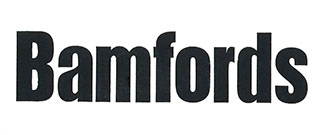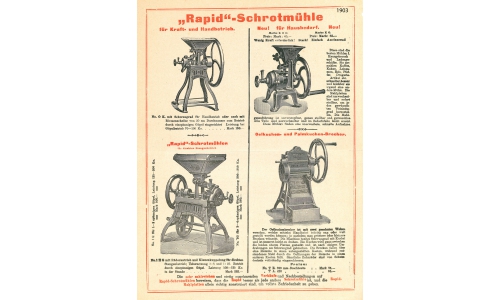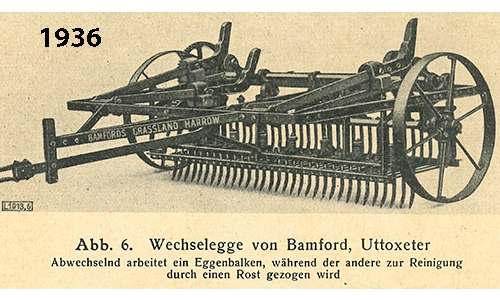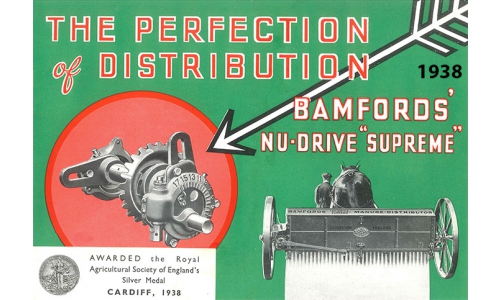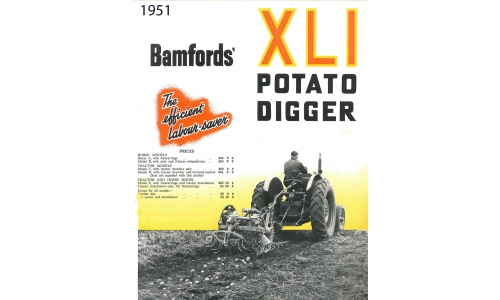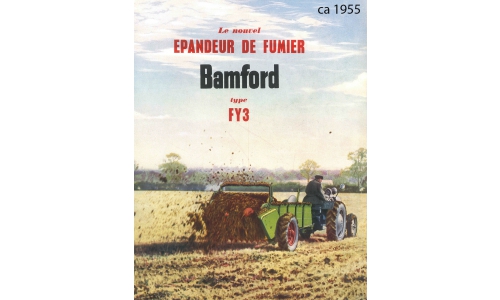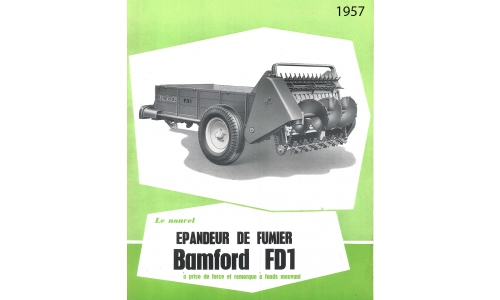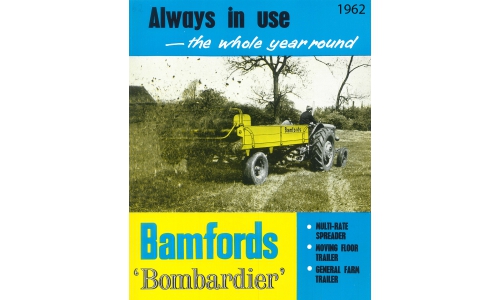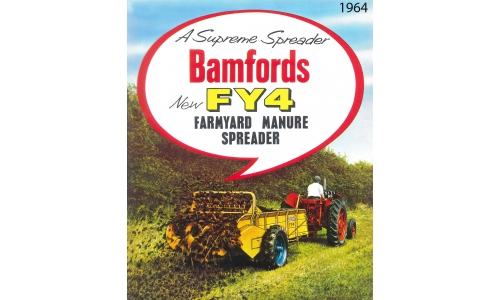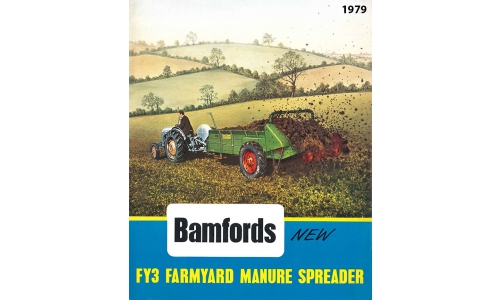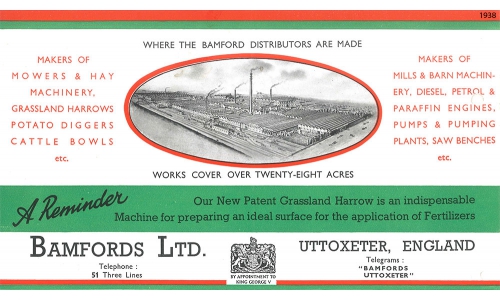
Die lange und ereignisreiche Geschichte des Familienunternehmen Bamfords Limited begann bereits 1845. Inzwischen gibt es die Firma selbst nicht mehr, aus ihrer Schwesterfirma J. C. Bamfords Excavators Limited entwickelte sich der weltweit tätige Bau-, Industrie- und Landmaschinenhersteller JCB. Beide Unternehmen befanden sich durchgehend im Besitz der Familie Bamford.
Die Geschichte der Firmen begann 1845, als Henry Bamford auf einem Grundstück seines Schwiegervaters eine Eisenwarenhandlung eröffnete. Bald begann Samuel Bamford dort mit der Konstruktion kleiner Haushaltsgeräte. Einige Jahre später, 1871, gründeten Henry Bamford und sein Sohn Samuel die Firma Bamfords Limited.
Zunächst hatte das Unternehmen nur sechs Mitarbeiter, die vorwiegend Pferdegeschirre und Heumaschinen fertigten. Dank steigender Nachfrage stieg die Mitarbeiterzahl in den nächsten Jahren auf 30 an. 1882 stiegen Henry Bamfords andere Söhne John, Henry Junior, Robert und Joseph Bamford in das Unternehmen ein, im gleichen Jahr kam die erste Mähmaschine von Bamfords Ltd. auf den Markt.
Joseph Bamford verließ das Stammwerk allerdings schon 1883 wieder und wurde für einige Jahre Manager der Lichfield Agricultural Company, die Bamfords kurz zuvor übernommen hatte. Im Jahr 1896 starb Gründer Henry Bamford, im selben Jahr stiegen Samuel Bamfords Söhne Henry und Oswald ins Unternehmen ein.
In den folgenden Jahren vergrößerte die Bamfords Ltd. sowohl ihr Produktionsprogramm, als auch ihr Firmengelände kontinuierlich, 1905 stiegen auch Joseph Bamfords Söhne Cyril und Gerald in die Firma ein. 1910 brachte die Bamfords Ltd. ihren ersten Schwader auf den Markt.
Nach Ausbruch des Ersten Weltkriegs trat die Bamfords Ltd. dem Central Munitions Committee bei und stellte teilweise auf Rüstungsproduktion um, wobei Landmaschinen immer noch die oberste Priorität hatten. Nach Ende des Kriegs, 1920, begann das Unternehmen mit der Fertigung der ersten Motoren und wurde außerdem eingeladen, dem Kombinat „Agricultural and General Engineers Ltd.“ beizutreten, lehnte dies aber ab. Das Kombinat wurde einige Jahre später liquidiert.
Bald danach ergänzte der Triumph Kartoffelernter Bamfords Fertigungspalette, bevor 1927 eine Flut große Teile der Betriebsstätten stark beschädigte. Auch während des Zweiten Weltkriegs gab es einige Probleme: Fertigungsmaterial war knapp, sodass Bamfords seine Produktion Mäher beschränken musste. Außerdem übernahm Daimler einen Teil der Fabriken, um dort Panzerspähwagen zu bauen.
Joseph Bamford verließ in diesen Jahren den Betrieb und gründete 1945 die J. C. Bamford (Excavators) Limited (JCB) eine Fabrik für Bodenbearbeitungsmaschinen. Rupert, John, Vincent und Richard Bamfords, alle Enkel des Firmengründers, leiteten nun die Stammfirma. Ab 1955 übernahm Vincent Bamford die Firma schließlich allein.
Bamfords Ltd. produzierte inzwischen auch Ballenpressen in Lizenz der Long Manufacturing Company of Tarbobo, USA und war einziger Importeur der norwegischen Kverneland-Pflüge. 1967 startete die JCB einen Versuch, die Bamfords Limited zu übernehmen, der jedoch am Widerstand der Geschäftsführer scheiterte.
JCB übernahm daraufhin 1968 den Baumaschinenhersteller Chaseside und entwickelte sich bis heute zum drittgrößten Produzenten für Baumaschinen weltweit mit 22 Werken in verschiedenen Ländern. Das Unternehmen ist nach wie vor in den Händen der Familie Bamford, Vorstandsvorsitzender ist aktuell Sir Anthony Bamford.
Die Bamfords Ltd. hingegen wurde 1987 liquidiert.
___________
The long and eventful history of the family business Bamfords Ltd. began as early as 1845. In the meanwhile the company doesn’t exist anymore but from its affiliated company JC Bamfords Excavators Ltd. one of the world’s top three manufactures of construction and agricultural equipment developed: JCB.
In 1845, Henry Bamford started a hardware store and soon his son Samuel Bamford began to construct small household appliances for sale. In 1871, both founded the company Bamfords Ltd.
The little company started with just six employees who predominantly produced harnesses and hay rakes. Thanks to an increasing demand in the next couple of years, staff numbers rose to 30. In 1882, Henry Bamford’s other sons, John, Henry Jr., Robert and Joseph, joined the company and in the same year the first reaper was launched.
Joseph Bamford left the main plant already in 1883 to become the manager of the Lichfield Agricultural Company for a couple of years which was taken over by Bamford soon before. In 1896, the founder Henry Bamford died and at the same time Samuel Bamford’s sons Henry and Oswald joined the company.
In the following years, Bamfords Ltd. continuously expanded both its product range as well as the factory site. In 1905, Joseph Bamford’s sons Cyril and Gerald joined the company. In 1910, the first rotor rake was introduced. After WWI, the company started producing motors and shortly after that a potato harvester complemented the product range. In 1927, a flood destroyed most of the factory site though and during WWII production material was scarce and Daimler took over parts of the site to build armoured reconnaissance vehicle so the company had to limit its production to mowers.
During these years, Joseph Bamford left the company and founded the JC Bamford (Excavators) Ltd. (JCB), a company which was producing soil tillage equipment. Rupert, John, Vincent and Richard, all of them grandchildren of the founder Henry, managed the main plant from then on. From 1955 on Vincent Bamford was the sole general manager.
Bamfords Ltd. had started producing balers as licensed product of the Long Manufacturing Company of Tarbobo, USA, and was sole importer of Norwegian Kverneland ploughs by now. JCB tried to take over the company in 1967 but failed due to resistance of the General Manager.
In 1968, JCB took over the construction manufacturer Chaseside and is now worldwide present with 22 plants in different countries employing around 12,000 thousand people on four continents. JCB is still family-owned and known for agricultural equipment such as tractors and loaders. On the contrary, the Bamfords Ltd. was liquidated in 1987.
